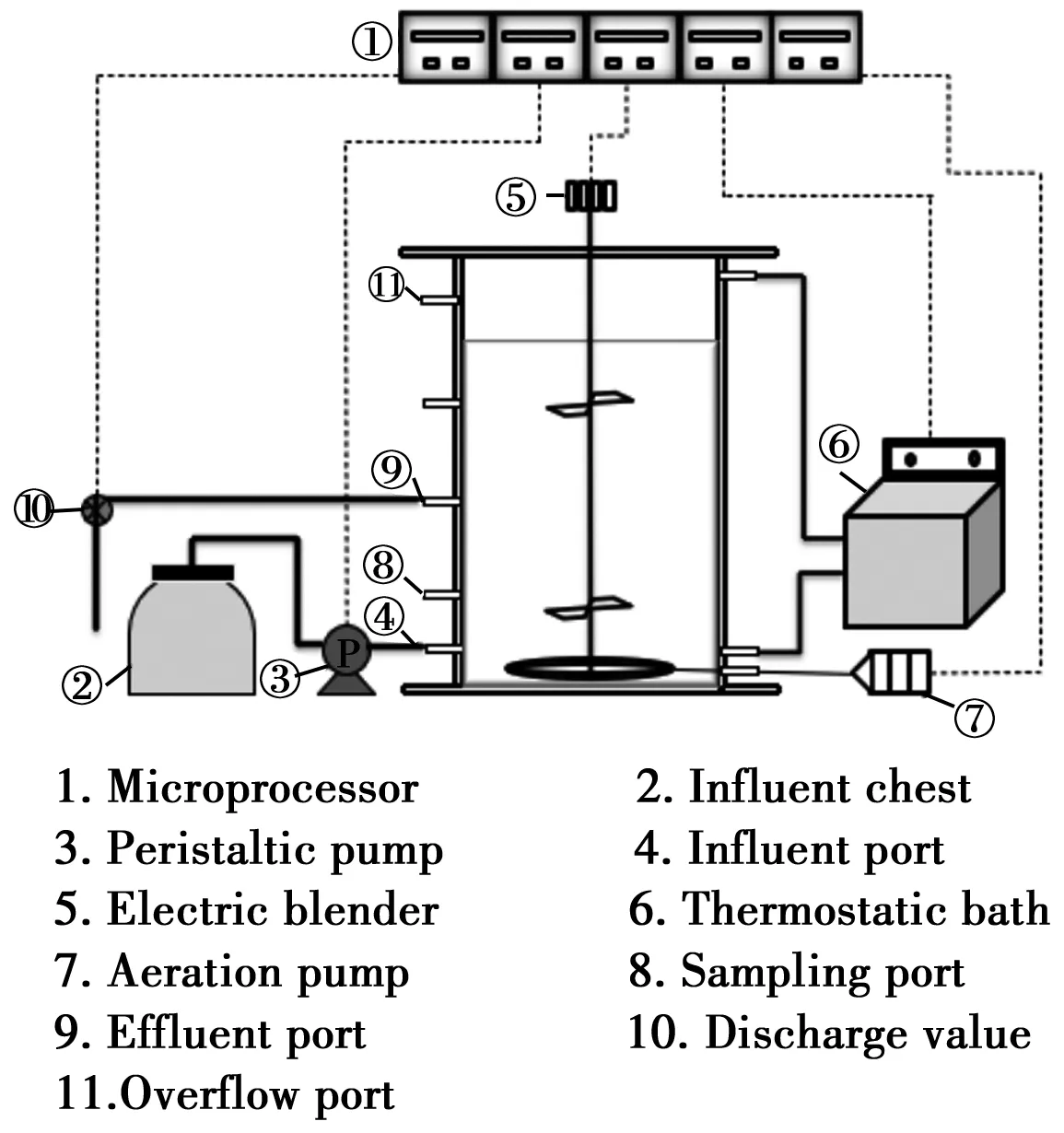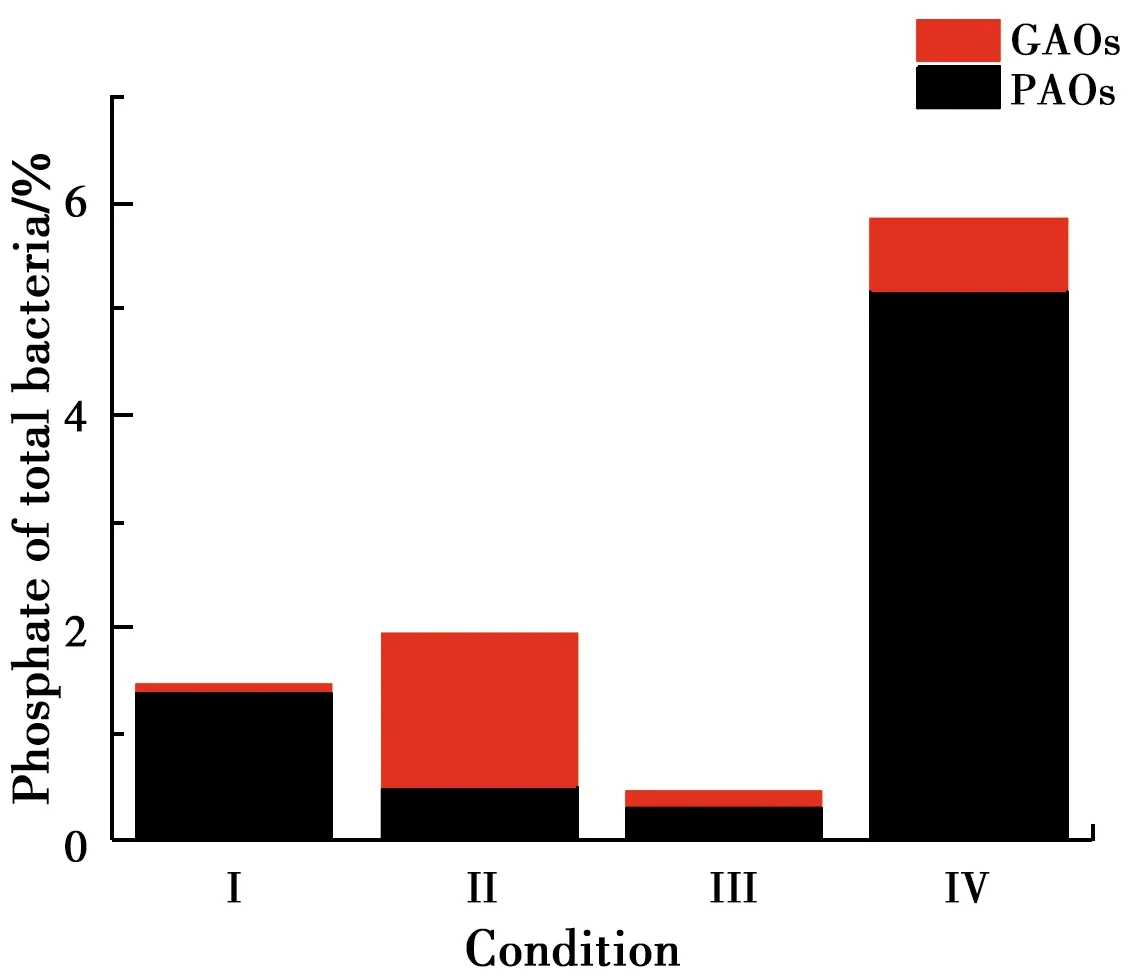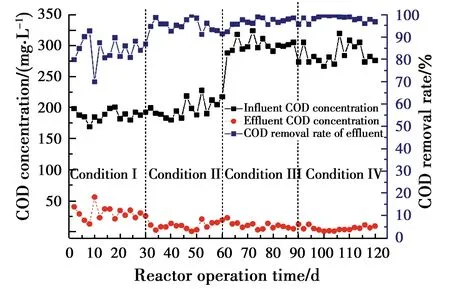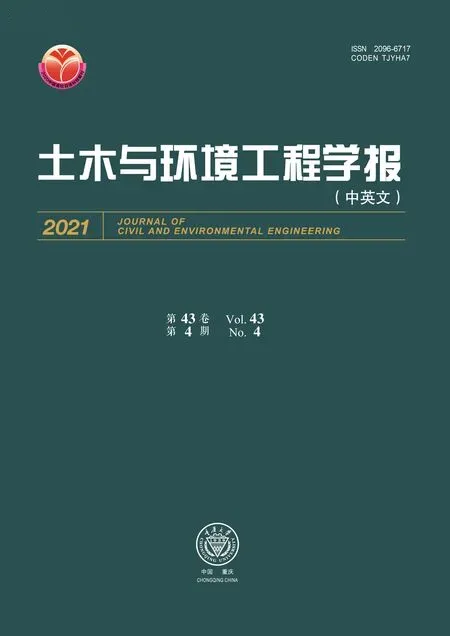Effect of operation conditions on the performance and microbial community of an enhanced biological phosphorus removal granular sludge system
2021-06-15,,,,,,,
, , , , , , ,
(School of Environmental and Municipal Engineering; Tianjin Key Laboratory of Aquatic Science and Technology; Joint Research Centre for Protective Infrastructure Technology and Environmental Green Bioprocess, Tianjin Chengjian University, Tianjin 300384, P. R. China)
Abstract: This study investigated factors influencing a sequencing batch reactor (SBR) enhanced biological phosphorus removal (EBPR) granular sludge system, in order to provide technical support for the practical application of EBPR. The start-up, the phosphorus removal performance of the EBPR granular sludge system and the sludge granulation were studied in a SBR system with a working volume of 12L, where sodium acetate was used as the carbon source and KH2PO4 was used as the phosphorus source. Results showed that when the carbon to phosphorus ratio of influent was too low (C∶P=200∶15), the phosphorus removal efficiencies were at a low level. Compared with 25 ℃, the EPS content of sludge increased at 15 ℃. Moreover, the increase of protein (PN) content was more obvious at 15 ℃, which was conducive to sludge granulation and resulted in an obvious increase of sludge particle size. Compared with 25 ℃, the lower temperature of 15 ℃ was more favorable for the growth of Rhodocyclus, which is mainly responsible for biological phosphorus removal in traditional EBPR systems. This resulted in Rhodocyclus becoming the dominant bacteria in the system and improved the phosphorus removal efficiencies.
Keywords:enhanced biological phosphorus removal (EBPR); extracellular polymer substances (EPS); micro granules; sludge granulation; bacterial community structure
1 Introduction
Water eutrophication is a hot issue in wastewater treatment. In recent years, the enhanced biological phosphorus removal (EBPR) process has been widely used as an economical and environmentally sustainable method to achieve phosphate removal from wastewater. In this type of wastewater treatment system, phosphorus accumulating organisms (PAOs) are the main phosphorus removal microorganisms[1]. The PAOs use intracellular glycogen and hydrolyzed poly-phosphorus (poly-P) to generate energy and absorb the external carbon source. PAOs store the carbon source in the form of poly-β-hydroxyalkanoates (PHAs). In aerobic conditions, PAOs use the energy obtained from PHA to absorb excessive phosphorus, so as to remove phosphorus from water[2-3]. The amount taken up is more than that released. This is usually called "luxury phosphorus uptake" and due to this, net phosphorus removal occurs[4]. In the actual operation process, the performance of the enhanced biological phosphorus removal (EBPR) process is affected by several factors, such as influent carbon source, carbon to phosphorus ratio, temperature, pH and so on. Therefore, the effect of different operation conditions on the performance and microbial community of an EBPR granular sludge system was compared in this study. Results provide a theoretical basis for the practical application of EBPR. Aerobic granular sludge (AGS) has the characteristics of good sedimentation, high microbial concentration, less excess sludge and simultaneous removal of multiple pollutants[5]. The mature granular sludge system has strong biological phosphorus removal ability, and the phosphorus removal efficiencies are close to 100%[6]. In recent years, the AGS process has been widely used. In contrast, the SBR granular biological phosphorus removal system and its influencing factors need further study.
Different influent phosphorus concentrations affect the metabolic function of organisms and the type of PAOs in the system. Research found that when the P/C ratio of influent water was too low, it led to the decrease of phosphorus accumulation in microorganisms. Additionally, the metabolism pattern of PAOs changed from poly-phosphorus metabolism to glycan metabolism[7].
Both water quality and process parameters have a great impact on phosphorus removal efficiencies[8]. When considering the carbon to phosphorus ratio, the optimal C/P is 50~70. Temperature is also one of the important parameters affecting the dominant bacteria and performance in the reactor. Temperature had a great influence on EPS. An increase in temperature led to the decrease of EPS content[9]. When the temperature was higher than 30 ℃, it was not conducive to the growth of PAOs, and more EPS hydrolysis occurred in the anaerobic phase[10]. Temperature can affect the transport of substances in microorganisms and the activity of enzymes. Temperature also affects the stable operation of an EBPR system[11]. When the temperature increased, the principal microbiological group in the EBPR system changed from PAOs to glycogen accumulating organisms(GAOs), which were more adaptable to the higher temperature environment[4, 12].
In most areas of northern China, the temperature changes greatly throughout the year. The influent water quality also has certain changes, so the microbial activity and the treatment effect of an EBPR system are greatly affected. Of note, the effect of operating parameters on sludge granules in EBPR systems has not been thoroughly studied. This study aims to investigate the performance of an EBPR process which operated at different conditions. The influence of operational parameters that included the C∶P ratio and operational temperature on phosphorus removal performance, sludge granulation and the microbial community were also evaluated.
2 Materials and methods
2.1 Reactor and operation
The SBR reactor(Fig.1) with a working volume of 12 L was operated for 4 cycles per day. Each cycle was 6 h in duration and consisted of 10 min filling, 85 min anaerobic phase, 150 min aerobic phase, 100 min settling time, 5 min effluent withdrawal and an inactive phase for 10 min. The peristaltic pump was used to feed water into the bottom of the reactor. The electric mixer was used to mix and stir the sludge. In the aerobic stage, the aeration plate was used for uniform aeration. The reactor was operated with a 15 d solid retention time (SRT) during the stable operation, based on the measured Mixed Liquor Solid (MLSS) and discharging part of sludge. The pH was controlled at 7.5~8.5 and the temperature of the reactor was controlled by a water jacket and a thermostat bath. This reactor was fed with CH3COONa as the carbon source, NH4Cl as the nitrogen source and KH2PO4as the phosphorus source. At 25 ℃, the C∶N∶P ratio of the influent was kept at 200∶10∶10 (condition 1), 200∶10∶15 (condition 2) and 300∶10∶15 (condition 3). At 15 ℃, the C∶N∶P ratio of the influent was kept at 300∶10∶15 (condition 4), and there was a time duration of 30 days in each condition.

Fig.1 Experimentalsetup
2.2 Influent compositions and seed sludge
The reactor was fed with synthetic wastewater. The C∶N∶P ratio of the influent was adjusted by changing the amount of carbon source, nitrogen source and phosphorus source. Other influent composition remained stable (Table 1) and 0.5 mL/L of a trace element solution was added to the influent (Table 2) in every condition. The reactor was seeded with activated sludge from the sewage treatment plant in Tianjin.

Table 1 Composition per 1 liter of synthetic wastewater

Table 2 Microelement solution components
2.3 Analysis and methods

The metagenomic DNA of total bacteria was extracted from the sludge sediment by a DNA Extraction Kit (omega, DNA), and the DNA concentration was determined. After DNA extraction, the variable region of 16S rRNA V3-V4 was amplified by Polymerase Chain Reaction (PCR) with a sampling RCR instrument. The primer sequence used for amplification was 338F (5 ′-ACTCCTRCGGGAGGGCAGCAG-3′), 806R (5′-GGACTACCAGGGTATCTAAT-3′). According to Illumina MiSeq system (Illumina MiSeq, USA), the cDNA library was sequenced by 2×300 BP high-throughput sequencing and the obtained DNA sequences were spliced. The quality control was carried out at the same time.
3 Results and analysis
3.1 Effect of operating conditions on bacterial structure
As showing in Fig.2, under different operating conditions, the relative abundance of sludge was significantly different at the genus level. Bacteria with phosphorus removal function that were detected in the system includedAeromonas,Dechloromonas,PseudomonasandRhodocyclus.Rhodocycluswas the main microorganism responsible for biological phosphorus removal in the traditional EBPR system. The results[13-14]showed that the relative abundance of this genus increased with the formation of aerobic granular sludge. Under the condition of temperature lower than 20 ℃, PAOs had more competitive advantage than GAOs[15]. The total proportion of all bacteria with phosphorus removal function in the system was 1.4%, 0.51%, 0.33% and 5.17% under the four conditions studied, respectively. The reason for the obvious increase of proportion is that theRhodocycluswas significantly higher in condition 4 than the first three conditions.Rhodocycluswas not detected in the first three conditions, while in condition 4, the relative abundance ofRhodocycluswas 4.76% and it became the dominant bacteria in the system. The dominant species in the system wasChryseolinea(4.77%) under condition 1, and then decreased gradually after changing the operating conditions until it reached only 0.43% under condition 4. The abundance of the genusDefluviicoccuswas 0.07% in condition 1, while it increased to 1.44% in condition 2 and exceeded the total proportion of the PAOs. As a GAO,Defluviicoccuswould compete with PAOs for carbon source, and it does not have the function of phosphorus removal. Hence, an increase in this genus may be a factor in the noted deterioration of phosphorus removal performance in condition 2. It can be seen from Fig.3 that PAOs grew significantly at 15 ℃, which, for the purpose of phosphorus removal, was more advantageous than having a high percentage of GAOs. The percentages of various kinds of PAOs in the total amount under different working conditions are shown in Fig. 4. In the first three working conditions,Rhodocycluswas not detected. After the temperature reduced, the phosphorus removal performance of the system was better. The abundance ofRhodocyclusincreased significantly, becoming the dominant bacteria, which led to strong phosphorus removal ability.

Fig.2 Genus abundance of sludge in different

Fig.3 Percentage of PAOs and GAOs in total

Fig.4 Percentage of all kinds of PAO in total
Zoogloeacan induce microorganisms to microbial micelles under certain conditions. Such micelles play a key role in the tight structure of sludge microorganisms. This, in turn, makes sludge have good adsorption capacity and sedimentation performance[16]. Under four conditions,Zoogloeapercentage was 0.47%, 0, 0.07% and 0.97%, respectively. The increase in the percentage ofZoogloeamay be one of the reasons for sludge granulation.
In condition 4, PAOs replaced other bacteria and became the dominant bacteria, resulting in phosphorus removal efficiencies that were significantly improved. Some researchers found that temperature caused selective pressure on the dominant organisms[17]. It can be seen that 15 ℃ is more suitable forRhodocyclusthan 25 ℃. Proper temperature reduction can make PAOs become the dominant bacteria and thereby improve phosphorus removal efficiencies. Moreover, lower temperature is also more suitable for the growth ofZoogloea, which has an advantageous promoting effect on sludge granulation.
3.2 Effect of different operation conditions on extracellular polymer substances(EPS) and sludge particle size
3.2.1 Change of EPS
EPS can affect the properties and functions of microbial aggregates in biological wastewater treatment systems, especially in the formation of biofilm and granular sludge. EPS can combine cells through an ion bridge, hydrophobic interactions and polymerization. It also play a role in promoting the formation of granules[18]. EPS consists of a variety of complex polymers, such as proteins, polysaccharides, nucleic acids and lipids. Changes in operating conditions can affect the composition and structure of EPS[19].
As showing in Fig. 5, under the same temperature, the first three conditions only changed the ratio of C∶N∶P (200∶10∶10 → 200∶10∶15 → 300∶10∶15). The content of EPS decreased with these changes and the content of protein (PN) was 206.5 mg/L, 196.5 mg/L and 167 mg/L respectively. The content of polysaccharide (PS) decrease was not as obvious, with values of 114.445 mg/L, 106.495 mg/L and 104.485 mg/L respectively in the first three conditions. Under the condition of a C∶N∶P ratio of 300∶10∶15, when the temperature decreased from 25 ℃ to 15 ℃, the content of EPS increased significantly, including a PN content of 279 mg/L and PS content of 131.53 mg/L. Previous studies suggested that the total amount of EPS decreased with the increase of temperature, and EPS was easy to accumulate at low temperature[9]. PN improves the flocculation and stability of granular sludge, while PS increases the mechanical strength of granular sludge[20]. The results showed that the content of PN was higher than that of PS under four operating conditions, especially at 15 ℃ and the content of protein was 2.12 times higher than that of polysaccharide. The decrease of temperature can make the microorganism undergo a stress reaction, producing higher EPS. The increase of EPS content was helpful for the formation of microbial aggregates and to maintain the stability of sludge flocs and particles. When microorganisms were subjected to environmental stress (such as temperature change), the microorganisms mainly responded to the stress by secreting proteins[21]. For the EBPR activated sludge system, the migration and transformation of intracellular phosphorus and EPS phosphorus are closely related. The EBPR process was the result of the interaction of EPS and bacterial cells[22]. As a bridge between bacterial cells and the main liquid phase, EPS can protect PAOs from the pollution of toxic substances (such as heavy metals). The increase of EPS can improve the phosphorus removal efficiencies.

Fig.5 Content of protein (PN) and polysaccharide (PS) in extracellular polymer substances (EPS) under different conditions as well as their ratio (PN / PS)
3.2.2 Change of sludge particle size
Fig.6 shows the change of sludge particle size under four operating conditions. The average particle size of sludge in these four conditions was 81.584 μm, 92.941 μm, 81.049 μm and 233.46 μm respectively. The experimental results showed that when the temperature was constant and the only change was the influent C∶N∶P ratio, the resultant change of sludge particle size was not significant. In contrast, the change of temperature had a greater impact on sludge particle size. As shown in Fig.7, under working condition 4, the average particle size of sludge changed greatly every week, with values of 137.77 μm, 172.43 μm, 200.62 μm and 233.46 μm respectively in four consecutive weeks, and compared with 25 ℃, the particle size of sludge increased significantly at 15 ℃. The particle size of sludge also increases with the increase of EPS content. The increase of Zoogloea in the microbial community analysis is another factor related to the change of sludge particle size. Research shows that compared with mid-range mesophilic organisms, lower-range psychrophiles organisms showed excellent granular biomass formation ability[23]. Some studies have further shown that with the formation of Aerobic Granular Sludge(AGS), the relative abundance of Rhodocyclus increases[13-14].

Fig.6 Change of sludge particle size under

Fig.7 Change of sludge particle size per week under working condition
EPS plays a key role in the formation of aerobic granular sludge[24]. Some researchers found that the functional groups of certain amino acids in the protein had positive charge, which can reduce the electronegativity of sludge surface, increase its hydrophobicity, and facilitate sludge particles in approaching each other and gathering to form a stable particle structure[25]. There are a large number of extracellular proteins in granular sludge, and the core of EPS is mainly composed of proteins (PN), therefore, extracellular proteins play an important role in maintaining the integrity of granular sludge. The experimental results showed that the decrease of temperature made the EPS content increase, especially by increasing the PN. The reason for this is likely that the increase of PN strengthens the hydrophobicity of sludge, enhancing the aggregation and adhesion ability between suspended sludge. This results in the particle size of sludge increasing gradually, and eventually leads to the formation of granular sludge.
3.3 Effect of different operation conditions on pollutant removal performance
Fig. 8 shows the phosphorus removal performance of the reactor under different operating conditions. At 25 ℃, when the influent C∶N∶P ratio was 200∶10∶10 and the influent phosphorus concentration was kept at about 10 mg/L, the final effluent phosphorus concentration gradually decreased to less than 1 mg/L, and the phosphorus removal efficiency gradually increased to more than 90%, indicating a significant improvement on the phosphorus removal performance of this system. When the concentration of COD and N in the influent was constant, the concentration of phosphorus rose to 15 mg/L, the effluent phosphorus concentration rose to 8 mg/L, and the phosphorus removal efficiency gradually reduced to 35%. A typical cycle experiment showed that the anaerobic phosphorus release did not increase (Fig.9). However, when the influent COD increased to 300 mg/L and the influent C∶N∶P ratio was 300∶10∶15, the system consumed only 4.5 mg/L of influent phosphorus or less, and the phosphorus removal efficiency remained at 30%. This may be related to the gradual decrease of PAOs in the whole bacteria content as shown in Fig. 4. When the temperature reduced to 15 ℃, the influent C∶N∶P ratio was 300∶10∶15, the effluent phosphorus reduced to less than 1 mg/L and the phosphorus removal efficiency increased to more than 90%. A typical cycle experiment showed that the anaerobic phosphorus release and aerobic phosphorus uptake increased as the temperature decreased. Low temperature resulted in greater amounts of phosphate release and uptake, leading to better phosphorus removal performance, and this was positively correlated with the proportion of PAOs.

Fig.8 Phosphorus removal under different

Fig.9 Change of phosphorus in typical period
When the influent C/Pratio decreased from 40 to 10, the phosphorus release, absorption and phosphorus content of sludge all increased[26]. But this experiment found that, when the C∶P ratio was too low, the effluent quality deteriorated, maybe due to lack of carbon sources, and the presence of other heterotrophic bacteria such as GAOs which do not contribute to phosphorus removal but instead reduce the EBPR efficiencies. In the anaerobe stage, the synthesis of energy storage materials in PAOs was insufficient, which led to inadequate energy for excessive phosphorus uptake in the aerobic stage. When the temperature rose from 20 ℃ to 30 ℃, then to 35.5 ℃, the dominant microbiome changed from PAOs (44%~70%) to GAOs (64%~75%)[4]. In this study, when the temperature decreased from 25 ℃ to 15 ℃, there was a significant increase in the phosphorus removal efficiencies of the system. According to the analysis of bacterial abundance, the decrease of temperature made the abundance of Rhodocyclus increase significantly, which improved the phosphorus removal ability of the system. Because high content of EPS can significantly promote P adsorption and precipitation, it can achieve stable and effective removal of P[27]. The effect of operating conditions on EPS was also another factor affecting phosphorus removal.
Under four working conditions, the COD removal of the system is shown in Fig. 10, when the influent C∶N∶P ratio was 200∶10∶10, the influent COD concentration was 200 mg/L, and the effluent COD concentration was kept at about 50 mg/L. After running the reactor for 12 d, the effluent COD remained below 50 mg/L, and the COD removal efficiency was good under each operating condition. Under the four working conditions, the reactor had good COD removal capacity. When the C∶N∶P ratio was 300∶10∶15, there was no significant difference in COD removal efficiencies between 15 ℃ and 25 ℃.

Fig.10 Removal of organic pollutants under
4 Conclusions
1)When the influent C∶P ratio was low, there was a decrease in the phosphorus removal efficiencies of the system. This may be due to the relative lack of carbon source and the presence of other heterotrophic bacteria such as GAOs. Under such circumstances, the PAOs could not synthesize enough energy storage substance (PHA) in the anaerobic stage, and could not release energy for excessive phosphorus absorption in the aerobic stage, which resulted in the decrease of phosphorus removal efficiencies of the system.
2)Lower temperatures promote the production of EPS, especially the proportion of protein (PN) content, which enhanced the sludge hydrophobicity, the aggregation ability and adhesion ability between suspended sludge, and contributed to the formation of granular sludge.
3)At 15 ℃,Rhodocyclushas a higher growth rate and became the dominant PAO bacteria in the system, which improved the phosphorus removal efficiencies.
